- Clone
- BL168 (See other available formats)
- Regulatory Status
- RUO
- Other Names
- Interleukin IL-17A, IL-17, Cytotoxic T lymphocyte-associated antigen 8 (CTLA-8)
- Isotype
- Mouse IgG1, κ
- Ave. Rating
- Submit a Review
- Product Citations
- publications
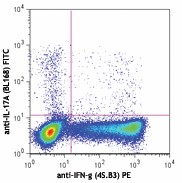
-

PMA (50 ng/ml) + ionomycin (1 µg/ml)-stimulated (6 hours + monensin, 2 µM) human peripheral blood lymphocytes intracellularly stained with anti-IFNγ (4S.B3) PE and anti-IL-17A (BL168) FITC
| Cat # | Size | Price | Save |
|---|---|---|---|
| 512301 | 50 µg | ¥19,580 | |
| 512302 | 500 µg | ¥56,760 |
IL-17A is the founding member of the IL-17 family, a group of six structurally related pro-inflammatory cytokines. IL-17A, secreted by activated CD4+ Th17 cell subpopulation, elicits multiple biological activities on a variety of cells including: the induction of IL-6, IL-8, G-CSF, and PGE2 production in epithelial, endothelial or fibroblasts; the enhancement of surface expression of ICAM-1 in fibroblasts; activation of NF-κB and costimulation of T cell proliferation. Recent studies demonstrated that, in mice, activated IL-17-secreting CD4+ helper T cells (Th17 cells) mediate an autoimmune arthritis that clinically and immunologically resembles rheumatoid arthritis (RA). Human IL-17A shows 63%, 63%, and 72% amino acid sequence identity to rat IL-17A, mouse IL-17A, and a protein encoded by the ORF13 gene of herpesvirus Saimiri (HVS), respectively.
Product DetailsProduct Details
- Verified Reactivity
- Human
- Antibody Type
- Monoclonal
- Host Species
- Mouse
- Immunogen
- Recombinant full length human IL-17A
- Formulation
- Phosphate-buffered solution, pH 7.2, containing 0.09% sodium azide.
- Preparation
- The antibody was purified by affinity chromatography.
- Concentration
- 0.5 mg/ml
- Storage & Handling
- The antibody solution should be stored undiluted between 2°C and 8°C.
- Application
-
ICFC - Quality tested
- Recommended Usage
-
Each lot of this antibody is quality control tested by immunofluorescent staining with flow cytometric analysis. For flow cytometric staining, the suggested use of this reagent is ≤ 0.25 µg per million cells in 100 µl volume or 100 µl of whole blood. It isrecommended that the reagent be titrated for optimalperformance for each application.
- Product Citations
-
- RRID
-
AB_961399 (BioLegend Cat. No. 512301)
AB_961399 (BioLegend Cat. No. 512302)
Antigen Details
- Structure
- Cytokine; dimer; ~15 kD (Mammalian)
- Bioactivity
- Secretion of IL-6, IL-8, G-CSF, prostaglandin E2 by epithelial, endothelial or fibroblastic cells; stimulates cell migration, cord formation, and IL-6 secretion by stromal cells
- Cell Sources
- Activated T cell subpopulation
- Cell Targets
- Fibroblasts, epithelial and endothelial cells, stromal cells
- Receptors
- IL-17R
- Cell Type
- Tregs
- Biology Area
- Cell Biology, Immunology, Neuroinflammation, Neuroscience
- Molecular Family
- Cytokines/Chemokines
- Antigen References
-
1. Hirota K, et al. 2007. J. Exp. Med. 204:41.
2. Furuzawa-Carballeda J, et al. 2007. Autoimmun. Rev. 6:169.
3. Witowski J, et al. 2007. Kidney Int. 71:514.
4. Gaffen SL, et al. 2006. Vitam. Horm. 74:255.
5. Hymowitz S, et al. 2001. EMBO J. 20:5332. - Gene ID
- 3605 View all products for this Gene ID
- UniProt
- View information about IL-17A on UniProt.org
Other Formats
View All IL-17A Reagents Request Custom ConjugationCompare Data Across All Formats
This data display is provided for general comparisons between formats.
Your actual data may vary due to variations in samples, target cells, instruments and their settings, staining conditions, and other factors.
If you need assistance with selecting the best format contact our expert technical support team.
-
Brilliant Violet 421™ anti-human IL-17A
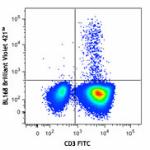
Human peripheral blood lymphocytes were stimulated with PMA ... 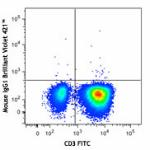
-
Purified anti-human IL-17A
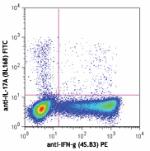
PMA (50 ng/ml) + ionomycin (1 µg/ml)-stimulated (6 hours + m... -
FITC anti-human IL-17A

Intracellularly stained anti-human IL-17A (BL168) FITC was b... 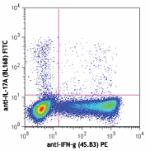
PMA + ionomycin stimulated human peripheral blood lymphocyte... 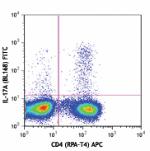
PMA (50 ng/ml) + ionomycin (1 µg/ml)-stimulated (6 hours + m... -
PE anti-human IL-17A
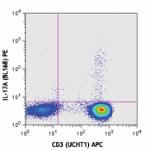
PMA (50 ng/ml) + ionomycin (1 µg/ml)-stimulated (6 hou... -
Alexa Fluor® 488 anti-human IL-17A

PMA (50 ng/ml ) + ionomycin (1 µg/ml)-stimulated (6 hours + ... -
Alexa Fluor® 647 anti-human IL-17A

PMA (50 ng/ml ) + ionomycin (1 µg/ml)-stimulated (6 ho... -
Pacific Blue™ anti-human IL-17A

PMA (50 ng/ml) +ionomycin (1 µg/ml)-stimulated (6 hours + mo... -
PerCP/Cyanine5.5 anti-human IL-17A

PMA + ionomycin-stimulated (6 hours) human peripheral blood ... -
PE/Cyanine7 anti-human IL-17A

PMA + ionomycin-stimulated (6 hours) human peripheral blood ... -
Alexa Fluor® 700 anti-human IL-17A
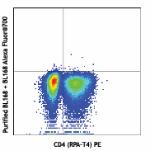
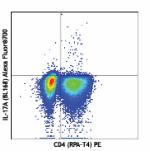
PMA (50 ng/ml) + ionomycin (1 µg/ml)-stimulated (6 hou... -
APC/Cyanine7 anti-human IL-17A

PMA + ionomycin-stimulated (6 hours) human peripheral blood ... -
Brilliant Violet 570™ anti-human IL-17A

PMA + ionomycin-stimulated (6 hours) human peripheral blood ... 
-
Brilliant Violet 605™ anti-human IL-17A
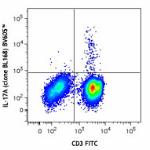
PMA + ionomycin-stimulated (6 hours) human peripheral blood ... 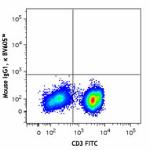
-
Brilliant Violet 711™ anti-human IL-17A
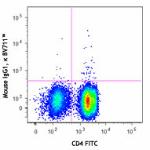

PMA + ionomycin-stimulated (6 hours) human peripheral blood ... -
Brilliant Violet 510™ anti-human IL-17A
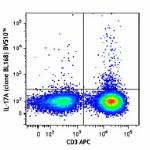
PMA+ ionomycin-stimulated human peripheral blood lymphocytes... 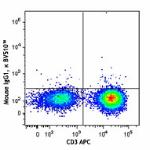
-
APC anti-human IL-17A
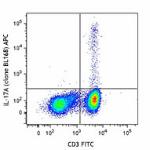
PMA + ionomycin - stimulated (6 hours) human peripheral bloo... 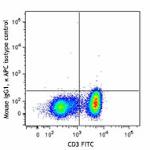
-
Purified anti-human IL-17A (Maxpar® Ready)
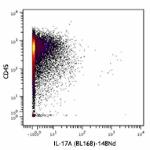
Human PBMCs were incubated for 6 hours in media alone (top) ... 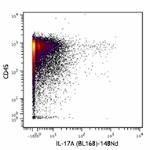
-
PE/Dazzle™ 594 anti-human IL-17A
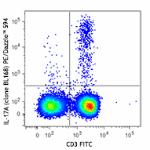
PMA + Ionomycin-stimulated (6 hours) human peripheral blood ... 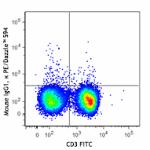
-
Brilliant Violet 785™ anti-human IL-17A
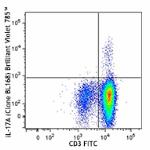
Human peripheral blood lymphocytes were stimulated with PMA ... 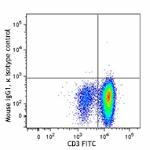
-
TotalSeq™-B1148 anti-human IL-17A
-
Spark UV™ 387 anti-human IL-17A

Human peripheral blood lymphocytes were stimulated with Cell... -
PE/Cyanine5 anti-human IL-17A

PMA+ ionomycin-stimulated (6 hours) peripheral blood mononuc...









Follow Us